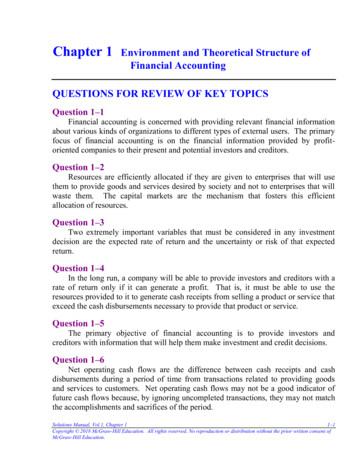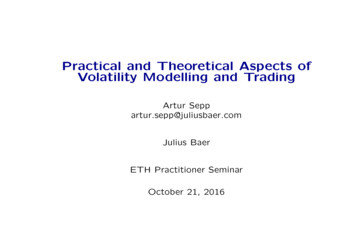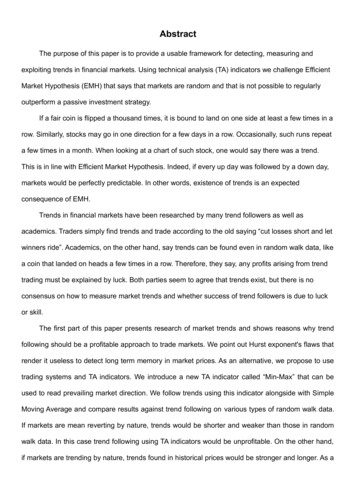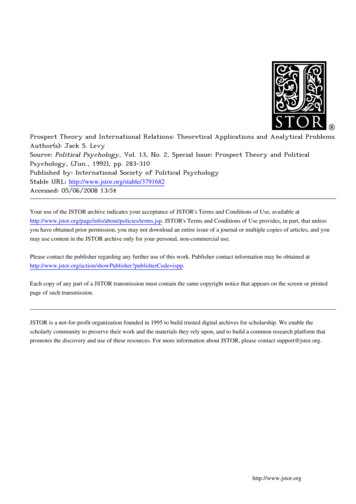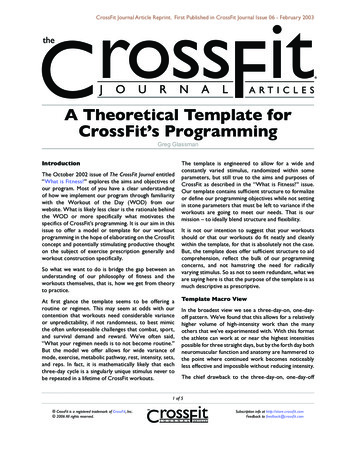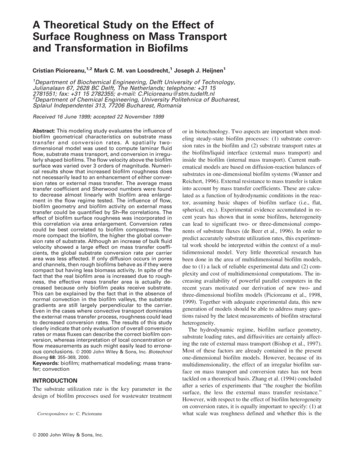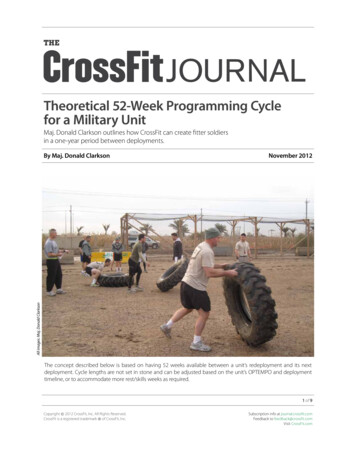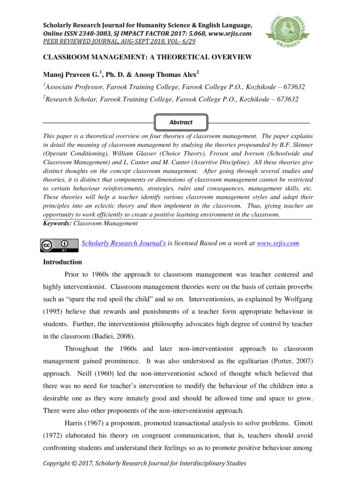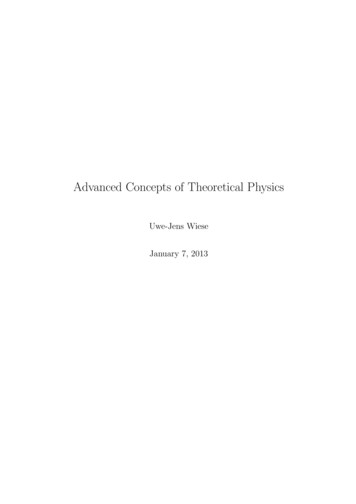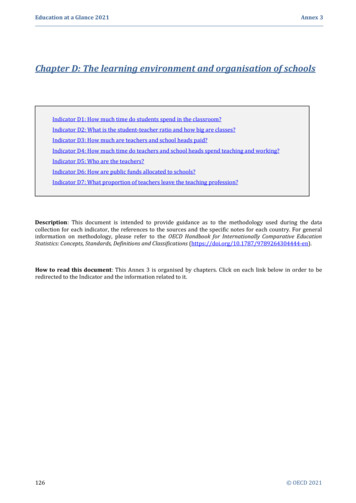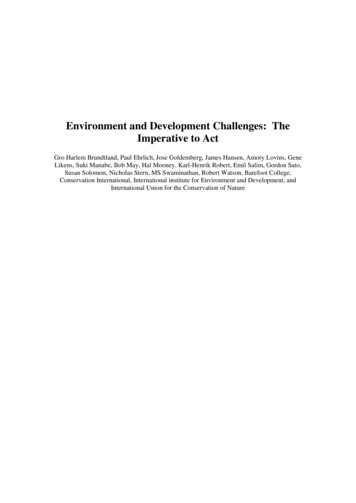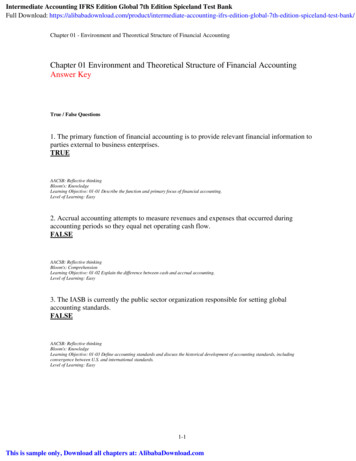
Transcription
Intermediate Accounting IFRS Edition Global 7th Edition Spiceland Test BankFull Download: d-test-bank/Chapter 01 - Environment and Theoretical Structure of Financial AccountingChapter 01 Environment and Theoretical Structure of Financial AccountingAnswer KeyTrue / False Questions1. The primary function of financial accounting is to provide relevant financial information toparties external to business enterprises.TRUEAACSB: Reflective thinkingBloom's: KnowledgeLearning Objective: 01-01 Describe the function and primary focus of financial accounting.Level of Learning: Easy2. Accrual accounting attempts to measure revenues and expenses that occurred duringaccounting periods so they equal net operating cash flow.FALSEAACSB: Reflective thinkingBloom's: ComprehensionLearning Objective: 01-02 Explain the difference between cash and accrual accounting.Level of Learning: Easy3. The IASB is currently the public sector organization responsible for setting globalaccounting standards.FALSEAACSB: Reflective thinkingBloom's: KnowledgeLearning Objective: 01-03 Define accounting standards and discuss the historical development of accounting standards, includingconvergence between U.S. and international standards.Level of Learning: Easy1-1This is sample only, Download all chapters at: AlibabaDownload.com
Chapter 01 - Environment and Theoretical Structure of Financial Accounting4. The Public Reform and Investor Protection Act of 2002 (Sarbanes-Oxley) changed theentity responsible for setting auditing standards in the United States.TRUEAACSB: Reflective thinkingBloom's: KnowledgeLearning Objective: 01-04 Explain why the establishment of accounting standards is characterized as a political process.Level of Learning: Easy5. A rules-based approach to standard setting stresses professional judgment as opposed tofollowing a list of rules.FALSEAACSB: Reflective thinkingBloom's: KnowledgeLearning Objective: 01-04 Explain why the establishment of accounting standards is characterized as a political process.Level of Learning: Easy6. Standard setters have sometimes changed standards in response to intense politicalpressure.TRUEAACSB: Reflective thinkingBloom's: KnowledgeLearning Objective: 01-04 Explain why the establishment of accounting standards is characterized as a political process.Level of Learning: Easy7. The primary responsibility for properly applying accounting standards whencommunicating with investors and creditors through financial statements lies with a firm'sauditors.FALSEAACSB: Reflective thinkingBloom's: KnowledgeLearning Objective: 01-04 Explain why the establishment of accounting standards is characterized as a political process.Level of Learning: Easy1-2
Chapter 01 - Environment and Theoretical Structure of Financial Accounting8. Auditors play an important role in the resource allocation process by adding credibility tofinancial statements.TRUEAACSB: Reflective thinkingBloom's: KnowledgeLearning Objective: 01-04 Explain why the establishment of accounting standards is characterized as a political process.Level of Learning: Easy9. Materiality can be affected by the dollar amount of an item, the nature of the item, or both.TRUEAACSB: Reflective thinkingBloom's: KnowledgeLearning Objective: 01-06 Identify the objective of financial reporting, the qualitative characteristics of financial reporting information, andthe elements of financial statements.Level of Learning: Easy10. Conservatism is a desired qualitative characteristic of accounting information.FALSEAACSB: Reflective thinkingBloom's: KnowledgeLearning Objective: 01-06 Identify the objective of financial reporting, the qualitative characteristics of financial reporting information, andthe elements of financial statements.Level of Learning: Easy11. Equity is a residual amount representing the owner's interest in the assets of the businessafter deducting all its liabilities.TRUEAACSB: Reflective thinkingBloom's: KnowledgeLearning Objective: 01-06 Identify the objective of financial reporting, the qualitative characteristics of financial reporting information, andthe elements of financial statements.Level of Learning: Easy1-3
Chapter 01 - Environment and Theoretical Structure of Financial Accounting12. Revenues are the increases in economic benefits in the form of increases in assets ordecreases in liabilities from activities that constitute the entity's ongoing operations.TRUEAACSB: Reflective thinkingBloom's: KnowledgeLearning Objective: 01-06 Identify the objective of financial reporting, the qualitative characteristics of financial reporting information, andthe elements of financial statements.Level of Learning: Easy13. Gains or losses result, respectively, from the disposition of business assets for greaterthan, or less than, their book values.TRUEAACSB: Reflective thinkingBloom's: KnowledgeLearning Objective: 01-06 Identify the objective of financial reporting, the qualitative characteristics of financial reporting information, andthe elements of financial statements.Level of Learning: Easy14. Comprehensive income is another term for net income.FALSEAACSB: Reflective thinkingBloom's: KnowledgeLearning Objective: 01-06 Identify the objective of financial reporting, the qualitative characteristics of financial reporting information, andthe elements of financial statements.Level of Learning: Easy15. Determining fair value by calculating the present value of future cash flows is a level 1type of input.FALSEAACSB: Reflective thinkingBloom's: KnowledgeLearning Objective: 01-08 Describe the recognition, measurement and disclosure concepts that guide accounting practice.Level of Learning: Easy1-4
Chapter 01 - Environment and Theoretical Structure of Financial Accounting16. The IASB's framework for measuring fair value doesn't change the situations in which fairvalue is used under current IFRS.TRUEAACSB: Reflective thinkingBloom's: KnowledgeLearning Objective: 01-08 Describe the recognition, measurement and disclosure concepts that guide accounting practice.Level of Learning: EasyMatching Questions17. Listed below are five terms followed by a list of phrases that describe or characterize theterms. Match each phrase with the correct term by placing the letter designating the best termin the space provided by the phrase.1. Predictive value2. Relevance3. Distribution to owners4. Confirmatory value5. TimelinessInformation is useful in projecting cash flows.Pertinent to the decision at hand.Information is available prior to the decision.Decrease in equity due to transfers to owners.Information confirms expectations.12534AACSB: Reflective thinkingBloom's: Comprehension18. Listed below are five terms followed by a list of phrases that describe or characterize theterms. Match each phrase with the correct term by placing the letter designating the best termin the space provided by the phrase.1. Gain2. Materiality3. Completeness4. Comprehensiveincome5. FaithfulrepresentationAlong with relevance, a fundamental decisionspecific quality. 5Results if an asset is sold for more than book value. 1Information contains all information necessary forfaithful representation. 3The change in equity from nonowner transactions. 4Concerns the decision-making impact of both theamount and nature of an item. 2AACSB: Reflective thinkingBloom's: Comprehension1-5
Chapter 01 - Environment and Theoretical Structure of Financial Accounting19. Listed below are five terms followed by a list of phrases that describe or characterize theterms. Match each phrase with the correct term with their phrases by placing the letterdesignating the best term in the space provided by the phrase.1. Neutrality2. Comparability3. Consistency4. Costeffectiveness5. RecognitionImportant in analysis between firms. 2Accounting information should be unbiased. 1The process of including data in financial statements. 5Applying the same accounting practices over time. 3Considers the value of using information relative tocost of providing it. 4AACSB: Reflective thinkingBloom's: Comprehension20. Listed below are five terms are followed by a list of phrases that describe or characterizethe terms. Match each phrase with the correct term by placing the letter designating the bestterm in the space provided by the phrase.1. Monetary unitassumption2. Verifiability3. Economic entityassumption4. Going concernassumption5. Periodicity assumptionImplies consensus among different observers.Assumes all transactions can be identified with aparticular entity.Assumes an entity will continue to operateindefinitely.Requires reporting the financial life of an entity indiscrete time frames.Ignores the possibility of inflation.AACSB: Reflective thinkingBloom's: Comprehension1-623451
Chapter 01 - Environment and Theoretical Structure of Financial Accounting21. Listed below are five terms followed by a list of phrases that describe or characterize theterms. Match each phrase with the correct term by placing the letter designating the best termin the space provided by the phrase.1. Historical costprinciple2. Materiality3. Matching principle4. Full-disclosureprinciple5. Revenue recognitionBasis of measurement for fixed assets.Recognition of revenue only after certain criteriaare satisfied.Guide to expense recognition.Reporting of all information that could affectdecisions.Application of GAAP sometimes avoided underthis constraint.15342AACSB: Reflective thinkingBloom's: Comprehension22. Listed below are five terms followed by a list of phrases that describe or characterize theterms. Match each phrase with the correct term by placing the letter designating the best termin the space provided by the phrase.1. International AccountingStandards Board2. International AccountingStandards Committee3. Relevance4. Financial AccountingStandards Board5. Securities and ExchangeCommissionIt is one of the fundamental qualitativecharacteristics of financial information.It developed global accounting standardsbefore the IASB.It develops global accounting standards.It has the authority to set U.S. accountingstandards.3215It develops U.S. GAAP in the U.S. 4AACSB: Reflective thinkingBloom's: Comprehension1-7
Chapter 01 - Environment and Theoretical Structure of Financial Accounting23. Listed below are five terms followed by a list of phrases that describe or characterize theterms. Match each phrase with the correct term by placing the letter designating the best termin the space provided by the phrase.1. Expenses2. Equity3. Distributions toowners4. Investments byowners5. LiabilitiesNet assets. 2Outflows of resources to generate revenues. 1Cash dividends. 3Claims of creditors against the assets of a business. 5Transfers of resources in exchange for ordinary andpreference shares. 4AACSB: Reflective thinkingBloom's: Knowledge24. Listed below are five terms followed by a list of phrases that describe or characterize theterms. Match each phrase with the correct term by placing the letter designating the best termin the space provided by the phrase.1. Losses2. Assets3. Revenues4. Comprehensiveincome5. GainsNet outflows from peripheral transactions. 1Increases in equity from the sale of goods and/orservices. 3Results if an asset is sold for more than bookvalue. 5All changes in equity except owner transactions. 4Probable future economic benefits controlled byan entity. 2AACSB: Reflective thinkingBloom's: Knowledge1-8
Chapter 01 - Environment and Theoretical Structure of Financial Accounting25. Listed below are ten organizations followed by a list of phrases that describe orcharacterize the organizations. Match each phrase with the correct organization by placing theletter designating the best term in the space provided by the phrase.1. SEC2. FASB3. IASB4. AICPA5. IFRSInterpretationsCommittee6. MonitoringBoard7. IFRS AdvisoryCouncil8. IASC9. APB10. IFRSFoundationProvides regulatory oversight to the IASB.Provides advice to the IASB on agenda and priorities.Sets accounting standards in the U.S.Provides timely responses to financial reporting issues.6725The IASB's parent organization. 10IASB's predecessor. 8FASB's predecessor. 9Regulates the financial reporting for public companies inthe U.S. 1Professional organization of certified public accountantsin the U.S. 4Sets global accounting standards. 3AACSB: Reflective thinkingBloom's: KnowledgeMultiple Choice Questions26. External decision makers would not look primarily to financial accounting information toassist them in making decisions on:A. Granting credit.B. Capital budgeting.C. Selecting shares.D. Mergers and acquisitions.AACSB: Reflective thinkingBloom's: ComprehensionLearning Objective: 01-01 Describe the function and primary focus of financial accounting.Level of Learning: Easy1-9
Chapter 01 - Environment and Theoretical Structure of Financial Accounting27. Corporations issue their shares to the investing public in the:A. Option AB. Option BC. Option CD. Option DAACSB: Reflective thinkingBloom's: KnowledgeLearning Objective: 01-01 Describe the function and primary focus of financial accounting.Level of Learning: Easy28. The primary focus for financial accounting information is to provide information usefulfor:A. Option AB. Option BC. Option CD. Option DAACSB: Reflective thinkingBloom's: KnowledgeLearning Objective: 01-01 Describe the function and primary focus of financial accounting.Level of Learning: Easy1-10
Chapter 01 - Environment and Theoretical Structure of Financial Accounting29. Which of the following is not true about net operating cash flow?A. It is the difference between cash receipts and cash disbursements from providing goodsand services.B. It is a measure used in accrual accounting and is recognized as the best predictor of futureoperating cash flows.C. Over short periods of time, it may not be indicative of long-run cash-generating ability.D. It is easy to understand and all information required t
Chapter 01 Environment and Theoretical Structure of Financial Accounting Answer Key True / False Questions 1. The primary function of financial accounting is to provide relevant financial information to parties external to business enterprises. TRUE AACSB: Reflective thinking Bloom's: Knowledge Learning Objective: 01-01 Describe the function and primary focus of financial accounting. Level of .
